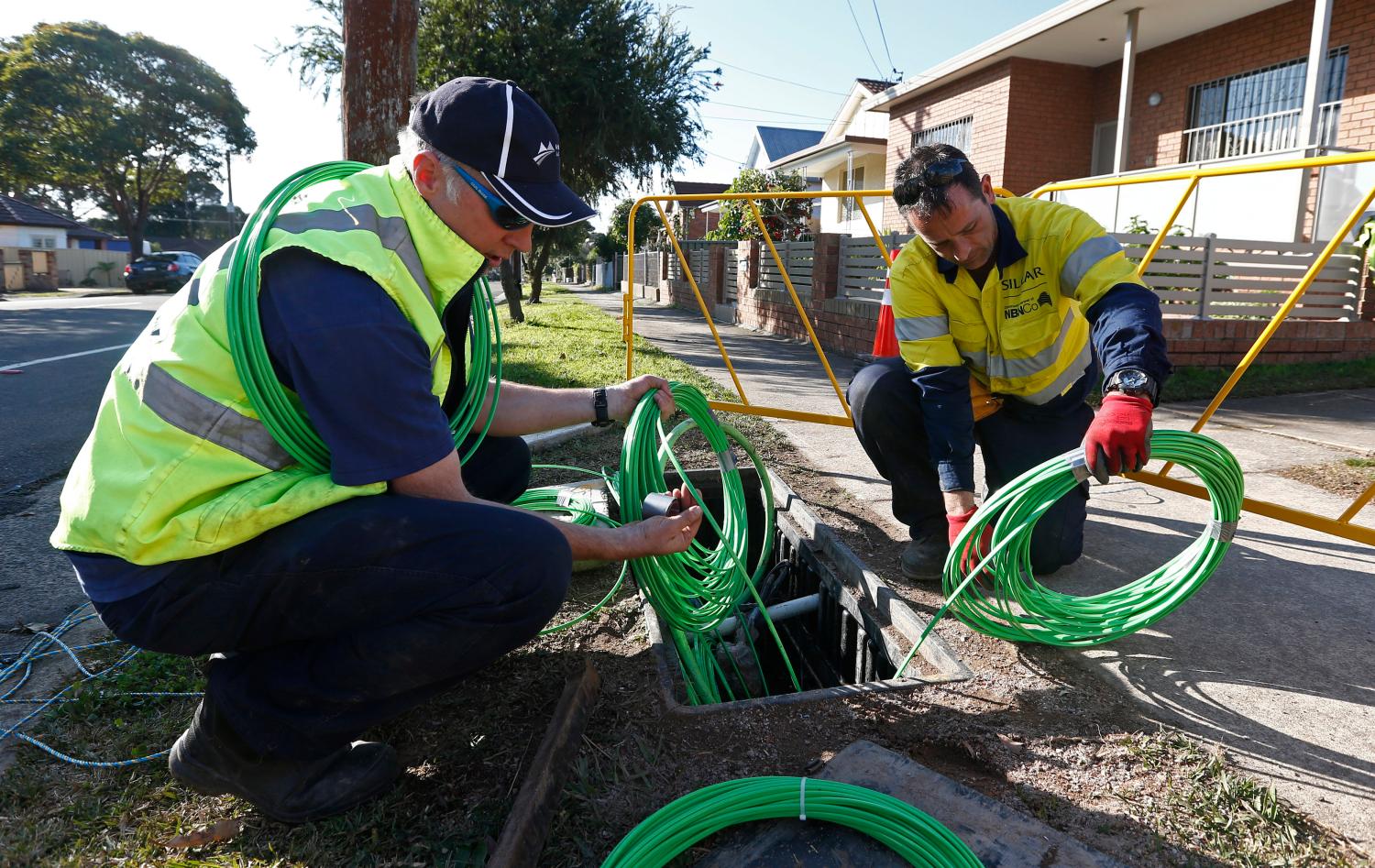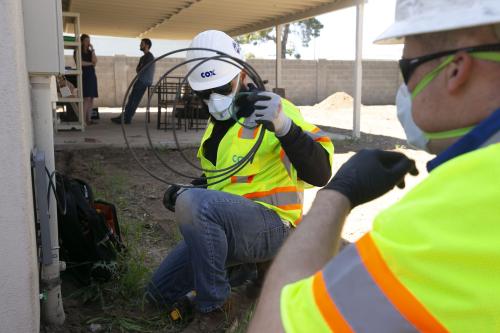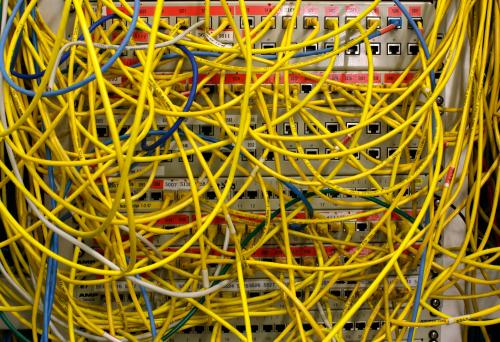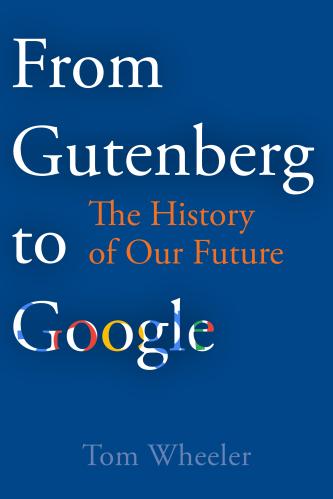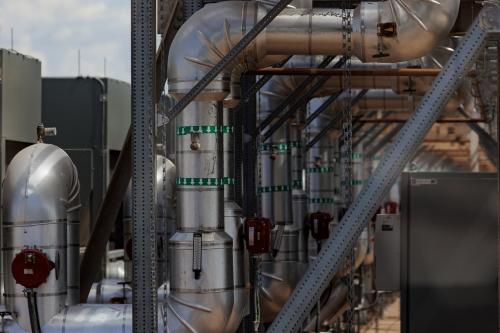The COVID-19 pandemic has highlighted the critical nature of access to fast and affordable internet service. Demand for high-speed internet access, defined as “broadband,” has soared to new heights. One measurement found that in only a few weeks the pandemic drove almost a year’s worth of broadband traffic growth.
The internet is no longer “nice to have,” it is critical. Whether working and studying from home or applying for unemployment compensation, the internet has kept activities alive. Seeing friends and visiting the doctor without infecting yourself or others became possible under the lockdown because of high-speed internet connections.
Our reliance on the internet during coronavirus has recast how we will behave after the crisis has passed. The big lesson is that we have incorporated the internet as a critical part of our personal and professional lives. This is not going to change. The crisis has sped us forward to a paradigm shift in which we rely on the internet to bring economic and social activity to us—rather than us going to them.
“[T]ens of millions of Americans do not have access to or cannot afford quality internet service.”
Yet, tens of millions of Americans do not have access to or cannot afford quality internet service. The United States has an internet access problem, especially in rural areas. The existing program to extend broadband has become a corporate entitlement for incumbent telephone companies. At the same time, the United States has an internet affordability problem. Too many low-income Americans cannot afford broadband internet access.
The digital chasm: Availability and affordability
Availability
Released in April, the Federal Communications Commission’s (FCC) 2020 Broadband Development Report identified approximately 18 million Americans—principally in rural areas—without access to any broadband network. The report was criticized for continuing to rely on inaccurate mapping data that skews the numbers to be more favorable than reality. An independent review of the FCC’s 2019 report found that the agency seriously undercounted unserved Americans, with the actual unserved population twice as large as the FCC claimed.
“Perhaps the silver lining of COVID-19’s dark cloud is the increased awareness that the current system for supporting access to high-speed broadband has failed.”
Quibbling over numbers, however, cannot mask a significant shortfall in rural internet access despite decades of programs in which the federal government subsidized the expansion of connectivity into rural America. Over the past five years alone, the federal government has provided over $22 billion to support the expansion of rural broadband. Yet, somewhere between 6% and 12% of Americans still do not have access to a quality broadband network.
Today, however, it can no longer be business as usual. Perhaps the silver lining of COVID-19’s dark cloud is the increased awareness that the current system for supporting access to high-speed broadband has failed. The FCC’s ability to track broadband coverage is so poor that the agency cannot reliably identify who has access to high-speed internet service and who does not. Simple observation tells us, however, that Americans living in the predominantly red counties of rural America have the worst internet access in the country.
Affordability
Hiding in plain sight is another reality: Low-income Americans—especially within urban areas of blue states—may have the internet outside their door, but cannot afford its monthly fee. The Reagan administration started, and Congress subsequently wrote into law, a subsidy to assure low-income Americans had access to telephone service and the ability to call 9-1-1. Called “Lifeline,” the program subsidized $9.25 per month for basic phone connectivity. Subsequent reforms applied that support to a wireless smartphone. While wireless access is a step in the right direction, relying on the small screen, slower speeds, high cost and lower usage limits of a smartphone is not a viable substitute for high-speed fixed broadband.
We hear often about the “digital divide” in America. The challenge is greater than that, however. It is what Jon Sallet calls the “digital chasm”—a cluster of digital divides that are larger, longer lasting, multi-faceted, and harder to close. Once and for all, it is time to attack the digital chasm. Any such effort begins with fixing America’s connectivity problem, both in terms of access and affordability.
I once had the responsibility, as chair of the FCC, to oversee the agency’s program to subsidize the expansion of internet access to unserved areas and low-income Americans. The limited headway we made was one of my greatest disappointments. I could point to political opposition to meaningful reforms or the political power of local service providers, but these would be excuses. The fact remains: We did not solve the problem.
Every American’s wired and wireless phone bill contains an ever-increasing monthly fee that is supposed to support the expansion of broadband to all. Currently, that fee is 21.2% of interstate and international call charges. Revenues from those charges, however, are declining as the internet replaces such old-style telephone services. The result forces the fee onto an ever-upward trajectory. It is a classic example of why a program designed in the telephone era needs to be replaced to reflect internet era realities.
Broadband and economic recovery
Multiple studies have shown a cause-and-effect relationship between high-speed internet access and economic growth. Eric Schmidt, the former CEO of Google who is now advising New York Gov. Andrew Cuomo on coronavirus recovery plans, told CBS’s “Face the Nation”: “All of a sudden, the internet is no longer optional. You can’t participate in this economy without access to the internet.” [Emphasis added]. Any congressional effort to focus on the economic recovery needs to fix the program failures that deny tens of millions of Americans the ability to “participate in this economy” in a manner critical for recovery.
While at the FCC, we estimated that it would cost about $80 billion for a one-time fix to deliver broadband to everyone. Where that money comes from is a matter for Congress to determine. The funds could come direct from the U.S. Treasury; they could come through a new financial structure such as a quasi-independent broadband bank; they could come from a more balanced assessment on internet services; or they could come from any other mechanism that Congress creates.
Regardless of how it is funded, the solution to universal broadband in America is not to patch the old program, but to throw it out. The program now in place was designed for a telephone-oriented world, not the internet economy. Here are five lessons we learned that should apply to any program to provide universal broadband for all Americans.
1. Demand high-speed service
The FCC determined in 2015 that “broadband” was internet service that delivered 25 megabits per second (mbps) downstream (i.e., to the home) and 3 mbps upstream (i.e., out of the home). At the time, this was described as the “table stakes” necessary to allow video streaming and a few in-home devices to work simultaneously. While technology and time have moved on—and COVID-19 has added to the importance of supporting multiple online devices in homes—the FCC’s broadband definition has not. This decision affects the quality of service that rural Americans receive from a subsidized network provider.
“While technology and time have moved on … the FCC’s broadband definition has not.”
Today, according to the FCC’s own data, more than 90% of all Americans (about 115 million homes) have access to connections of at least 100 mbps, while 85% can receive 250 mbps. The primary providers of this service are cable TV companies using a hybrid of fiber and coaxial cable.
Yet, because of the outdated definition of broadband, the money contributed by American ratepayers and taxpayers can be used to build substandard networks. All the FCC requires for a company to receive federal funds is to build the old definition of 25 mbps down and 3 mbps up. In other words, the FCC could be paying billions for the construction of rural networks offering service worse than what is available to nine-out-of-10 Americans.
The situation gets worse in the nation’s other rural broadband program. The recently passed $2 trillion CARES Act included funds for the Department of Agriculture’s Rural Utilities Service to make loans for rural broadband service. Notably, that law specifically prohibits the money to be spent to upgrade sub-standard connections. If the service is a decrepit 10 mbps downstream and 1 mbps upstream, the government won’t help bring it up to modern standards.
There are multiple ways to provide connectivity to unserved areas. Wireless operators promise that they are a solution. Satellite services point to how they already have a signal falling in the target areas. Wireless ISPs have been building their alternative. All these options improve connectivity where there is none, but there is a hierarchy of capabilities that any federal funding should recognize. The policy issue, therefore, becomes whether federal dollars should pay for a basic level of service, or strive for the kind of service enjoyed by the vast majority of other Americans? The answer is both, but the principal effort should first be for the high-speed, low-latency, future-proofed capabilities of fiber-optic cable.
Under current FCC funding rules, the federal support goes to the company that builds connections at the lowest price. While there have been some recent adjustments, the program pits high-performance, but also high-cost, fiber against the lower-cost, but lower-capability, alternatives. Such a “worse where there’s none” philosophy is understandable, and its goals laudable. But if we are going to spend federal dollars, we should first see if it is possible to build a service similar to what 90% of Americans enjoy. To do otherwise will only set us up for another digital divide down the road.
There may, indeed, be areas where it is simply impossible to provide a fiber connection. After all, there are still some remote spots not reached by the telephone network. When it comes to spending federal dollars contributed by taxpayers and ratepayers, however, the national strategy must be fiber first. The argument that support should be “technology neutral” too often has the practical effect of being “technology suboptimal.”
“[R]egardless of technology, a condition of federal money should be delivery of at least 100 mbps in the new construction of internet infrastructure.”
In the end, America’s broadband connectivity will be an ensemble of multiple solutions. That there are non-fiber solutions is fortunate, and they should be subsidized if fiber is not feasible. But we should try to build the optimal fiber solution first before funding alternatives. And, regardless of technology, a condition of federal money should be delivery of at least 100 mbps in the new construction of internet infrastructure.
The beauty of fiber-delivered broadband is that once the network is built, increases in throughput are an improvement in electronics without the need to string or lay more fiber. Moore’s Law—that microprocessor power grows while costs fall every couple of years—is the friend of rural broadband’s future ability to keep pace. But first it is necessary to pay to run the fiber.
2. Pay for the broadband connections directly
A major flaw in the FCC’s program has historically been to subsidize the operating costs of rural telephone companies rather than specifically funding broadband buildout. As one rural executive explained, the program “only paid you in arrears for the network you had already built.” Under the leadership of Chair Julius Genachowski in 2011, the FCC reformed the program to provide long-term funding assurances in return for a buildout commitment. I recall painful negotiations with local telephone companies over just how much they would spend on expanding their broadband reach in return for how much the FCC would subsidize.
The 2011 reforms led to the ongoing program to auction off the right to receive FCC support for unserved areas. It is a so-called “Dutch auction” where the company that agrees to the lowest subsidy to serve an area wins. The 2011 reforms were a step in the right direction, despite the issues caused by its “technology neutral” roots. The jury is still out on the Trump FCC’s implementation, in part because the FCC lacks precise information where there is inadequate service.
If we are to have universal access to high-speed broadband, we need to stop trying to reform a telephone-era program and focus directly on the goal of fiber everywhere. A model for this approach was the Great Recession stimulus bill, the American Recovery and Reinvestment Act of 2009. This law created the Broadband Technology Opportunities Program (BTOP) with $4 billion in funding for high-speed fiber construction. The money went directly to broadband construction of 233 projects across the nation. I have personally seen the success stories that resulted. In McKee, Kentucky, a one-traffic-light town in economically hard-hit Kentucky coal country, for instance, the telephone cooperative was given money to bring fiber to every home. The result was an increase in employment as citizens that had been hurt by the collapse of the coal economy took online jobs. In the hills of North Dakota, BTOP paid to install hundreds of miles of fiber-optic cable that were essential for local last-mile providers to offer rural customers a high-speed connection to the internet. The result made rural North Dakota the state with the nation’s best internet access. These success stories happened because the money went directly to pay for the capital costs of fiber infrastructure.
“If we are to have universal access to high-speed broadband, we need to stop trying to reform a telephone-era program and focus directly on the goal of fiber everywhere.”
Rural Americans do not have high-speed broadband because of the high cost of stringing or trenching fiber-optic cable across empty miles. Paying high capital costs to deliver to only a few subscribers is often hard to justify from a business standpoint. But it is not hard to justify the connections from a public-interest standpoint. Nor is it hard to justify from an economic-recovery standpoint. Connecting to the internet means connecting to jobs.
The internet has often been called the information superhighway. If all Americans are to have access to the internet, the answer is to step up and pay the necessary capital cost—just like we pay for the capital cost of building a physical highway.
3. Pay any qualified constructor
The goal of a national broadband program should be fiber connectivity. It should not matter who is providing those connections. For decades, local telephone companies have been subsidized with the expectation they would provide connections to the internet just like they connected almost everyone to the telephone network. They have failed in this goal. It is time to give others a chance.
Rural electric companies, for instance, have built a fiber network to manage the electricity grid. That fiber network could be a stepping stone for rural broadband as well. The goal should be fiber as far and wide as possible, regardless of who strings the cable.
The success of the FCC’s Schools and Libraries Program—known as “E-rate”—to connect educational institutions to the internet proves the power of looking beyond the local telephone company for fiber construction. Part of the surcharge added to each phone bill goes to subsidize high-speed connections to schools and libraries. The program was created as a part of the Telecommunications Act of 1996, thanks to the leadership of Vice President Al Gore. When the program was initiated, the internet was dial-up modems using telephone lines. By 2013, however, almost two decades later, only about a third of schools had a high-speed connection. Of those, only about half had WiFi to the classroom.
“The goal should be fiber as far and wide as possible, regardless of who strings the cable.”
When we overhauled E-rate in 2014, the FCC authorized construction funding to non-telephone companies. The incumbent companies opposed this vigorously. The program, however, pivoted from prioritizing who provides the service to the delivery of service at a reasonable price. In the end, 38% of the school districts that connected to fiber exercised this non-phone company option because their local provider could not or would not deliver service at a reasonable price.
By focusing on results rather than who provided the service: First, more schools were connected (both by independent contractors and by telephone companies that realized that if they didn’t build someone else would); and second, the existence of such a competitive alternative, together with technological improvements, drove bandwidth prices down.
I recall a meeting with a rural-telephone-company executive in which I asked why he was charging so much to connect a local school. His answer was essentially, “because I can.” After the E-rate reforms, that school had competitive alternatives that would be paid for by the FCC. Not surprisingly, that competition worked. Not only were schools and libraries connected, but prices fell as well. According to a study conducted by Education Superhighway, the average price that schools and libraries paid for high-speed connectivity fell from the pre-reform 2013 level of $22.00 per 1 mbps to $2.25 per 1 mbps in 2019. What’s more, whereas in 2013 there were 22,958 American schools without a fiber connection, in 2019 there were only 743.
Ninety-nine percent of American schools have 21st-century connectivity for their students because of the E-rate reforms, a key component of which was the funding of construction by any qualified provider.
4. Support state and local governments that want to step up
Most states have established a state-level broadband office or task force and many have established dedicated funds to support broadband expansion. While this has created the management challenge of avoiding double dipping into both federal and state funds for the same project, the more resources the better.
Such a “let’s all pull together to get broadband” approach was proven to work in the E-rate reforms that welcomed state-matching funds, above and beyond the basic federal program funds. As a result of that E-rate policy change, 23 states have provided over $200 million in matching funds. This state-federal partnership is a major reason why nearly all schools now have fiber connections.
It also makes sense that, if citizens working through their local government want to improve or extend their broadband service, they too should be eligible for support. Again, the policy issue should be how, not who. Approximately two-dozen states, however, restrict local governments from participating in broadband buildouts. In 2015 the FCC, finding that such laws were “largely sponsored and lobbied for by incumbent providers,” pre-empted such laws in Tennessee and North Carolina.
In Tennessee, for instance, the city of Chattanooga’s Electric Power Board (EBP) was providing gigabit speed broadband service to electric subscribers. Then a state law sprung up prohibiting them from extending to surrounding areas. The FCC’s record included the story of one individual who lived only about a thousand yards from EBP’s lines, but had to rely on a collage of services—including mobile hot spots, satellite TV, and phone service—that was not only more expensive, but also a less functional internet connection.
The incumbent networks took the FCC to court. Unfortunately, the court ruled that even though Congress had instructed the FCC to remove barriers to broadband connectivity, that authority did not extend to pre-empting state law.
Congress can change both of these unfortunate realities. If non-federal governments want to help their constituents receive better broadband, the FCC should be their ally, not their opponent.
5. Everyone counts or no one counts
The typical residential broadband connection in the United States costs over $60 per month. According to Pew Research, half of those who do not have broadband in their home say that’s because it is too expensive. Not only does the U.S. need a program that brings broadband past every door, it also needs a plan to bring it behind those doors and into homes.
COVID-19 dramatically illustrated the nation’s vulnerability. Of the approximately 50 million students sent home by school closings, over 9 million lack home internet access, principally because the household cannot afford it. What was once a “homework gap” has been revealed as an education opportunity gap.
“COVID-19 dramatically illustrated the nation’s vulnerability. Of the approximately 50 million students sent home by school closings, over 9 million lack home internet access.”
A study by the Benton Foundation found that low-income Americans can only afford to pay about $10 per month for broadband. Many of the nation’s largest broadband providers offer special low-cost packages for low-income Americans. Comcast—the nation’s largest broadband provider—recently improved their $9.95 “Internet Essentials” offer to 25 mbps down and 3 mbps up broadband, home WiFi, and no data caps. While such service levels are below what most Americans receive, they demonstrate the economic feasibility of the lower price. But the FCC’s Lifeline program does not support participation in these efforts because they are not offered by an “eligible telecommunications carrier” (i.e., a local telephone company).
As a result, because Lifeline was a telephone-era initiative, low-income Americans can only get supported access to the internet through a smartphone. Approximately 90% of Lifeline’s participants use it to support internet access off a smartphone. In other words, because Lifeline does not support fixed broadband, low-income Americans must rely on a service that is not as good as what a wired broadband connection offers.
This is not to cast aspersions on wireless internet access, but it is exponentially more difficult to do homework, apply for a job, or fill out unemployment-compensation paperwork on a phone’s small screen. Wireless Lifeline service is not an equivalent service. To be eligible for Lifeline subsidies, wireless providers need only offer network speeds of 3 mbps–substantially lower than even the “Internet Essentials” package—and data caps can be as low as 3 gigabits per month, despite the average American household using about 290 gigabits per month. Especially in a post-coronavirus era when online will be the economic lifeline, policy decisions should not force low-income Americans to limited internet service with small screens and slower speeds.
These issues can also be easily remedied by Congress. In the 21st century, a low-income subsidy for internet access is as important as telephone access was in the 20th century. Americans availing themselves of the program should be able to use it to obtain service from any qualified broadband provider, not just a telephone company. And the provision of such a low-income program should be a requirement if a company receives federal support to expand broadband.
Conclusion
The internet is the most powerful and pervasive platform in the history of the planet. During COVID-19, that platform has been the safety net for both businesses and individual workers. After the coronavirus pandemic passes, the internet will play an even greater role in all our lives.
It is time to leap the digital chasm.
The Brookings Institution is a nonprofit organization devoted to independent research and policy solutions. Its mission is to conduct high-quality, independent research and, based on that research, to provide innovative, practical recommendations for policymakers and the public. The conclusions and recommendations of any Brookings publication are solely those of its author(s), and do not reflect the views of the Institution, its management, or its other scholars.
Comcast and Google provide general, unrestricted support to The Brookings Institution. The findings, interpretations, and conclusions in this report are not influenced by any donation. Brookings recognizes that the value it provides is in its absolute commitment to quality, independence, and impact. Activities supported by its donors reflect this commitment.
The Brookings Institution is committed to quality, independence, and impact.
We are supported by a diverse array of funders. In line with our values and policies, each Brookings publication represents the sole views of its author(s).

